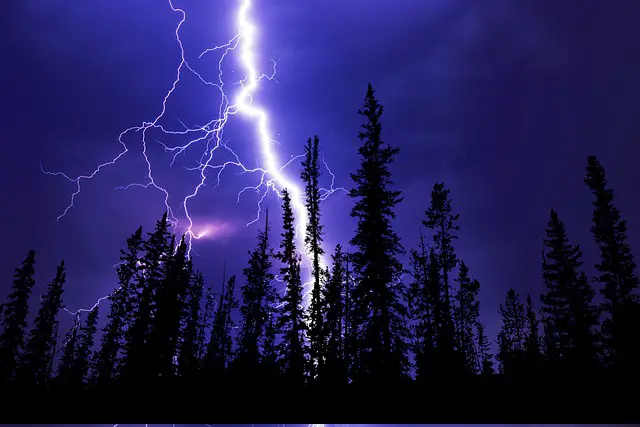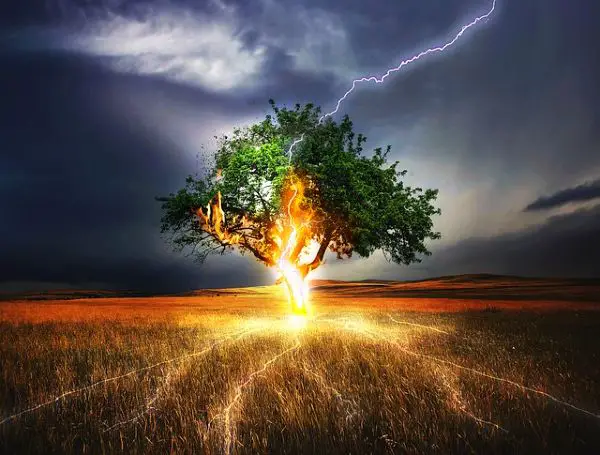
AFRILCATE
WHAT IS LIGHTNING?
Lightning is the visible electrical discharge in the atmosphere that occurs when cloud regions acquire excess electrical charge strong enough to break through the air resistance.
Lightning is the result of rapid charge movements in storm clouds.
WHAT CAUSES LIGHTNING?
Lightning is caused by imbalanced electric charges of cloud particles.
Different sized frozen water droplets, ice, and hails in cloud regions often collide with each other.
These collisions create electrical charges with some particles been positively charged and others, negatively charged.
Collision continues until the cloud becomes electrically saturated. At this point, the cloud is said to be charged up.
The lighter particles are positively charged and they rise to the top of the cloud.
The heavier particles, been negatively charged falls to the bottom of the cloud.
When individual charges grow large enough, an electric field is set up and lightning is released between oppositely charged regions.
WHY DOES LIGHTNING STRIKE THE GROUND?
An electrically saturated cloud region contains positively charged particles in the upper region and negatively charged particles in the lower cloud region.
Those charges in the clouds can cause changes on the ground.
The negatively charged cloud particles closer to the earth’s surface makes objects in the air beneath and on the ground level become positively charged.
This creates an electric field between the cloud and the ground surfaces.
The thunderhead pull from the cloud’s negative charged particles forces the ground positively charged particles to cluster at high points.
Air resistance acts as insulators between the cloud and ground surface.
When the charge becomes strong enough, it breaks through the resistance.
At this point, a stream of negative charges from the cloud called stepped leader rushes downwards towards high points on the ground which already contains clustered positive charges.
Due to the electrical attraction, the positive charge from the ground also rushes upward to link up with the negative charge, and a bright flash which we call lightning is formed.
What is seen to be only a single flash is actually a series of return strokes of electrical energy reaching back up into the cloud.
In other words, lightning strikes the ground due to imbalanced electrical charges formed between the ground surfaces and cloud regions.
The energy of the lightning strike contains hundreds of millions of volts and lasts only a fraction of seconds.
The sound heard after a lightning strike is called thunder.

WHAT CAUSES THUNDER?
Thunder is caused by the rapid expansion of the air surrounding the path traveled by a lightning bolt.
A bolt of lightning heats the air along its path causing it to expand rapidly.
The expansion creates a shock wave that turns into a booming sound wave, known as thunder.
We see lightning strike first before we hear the accompanying thunder because light travels faster than sound.
During a thunderstorm, lightning can occur within a cloud, between adjacent clouds, between the cloud and the air, or between the cloud and the ground.
This gives rise to various types of lighting.
TYPES OF LIGHTNING
- Intra-Cloud Lightning
- Inter-Cloud Lightning
- Cloud-to-Ground Lightning
- Sheet Lightning
- Forked Lightning
- Heat Lightning
- High – Altitude Lightning
- Anvil Lightning
- Ball Lightning

- Intracloud Lightning: This is the most common type of lightning. This occurs when there are both positive and negative charges within the same cloud. About three-quarters of all lightning on Earth never leaves the cloud where it formed.
- Intercloud Lightning: This is when a lightning strike occurs between charged particles of different clouds and the strike travels in the air between them.
- Cloud-to-Ground Lightning: This is lightning that strikes from the negatively charged bottom of the cloud traveling to the positively charged ground below. It’s the most dangerous type of lightning and each bolt can contain up to one billion volts of electricity.
- Sheet Lightning: This lightning appears as flashes of light that seem to light up or illuminate entire clouds. The name is often interchanged with intracloud lighting.
- Forked Lightning: This appears as jagged lines of light. They can have several branches. Forked lightning can be seen shooting from the clouds to the ground, from one cloud to another cloud, or from a cloud out into the air. This lightning can strike up to 10 miles away from a thunderstorm.
- Heat Lightning: This is a term used to describe lightning flashes that are too far away from you to hear the thunder. The reason that it is called heat lightning is that it appears most often on a hot summer day when the sky is clear overhead.
- High – Altitude Lightning: This lightning type has been given other names such as “red sprites,” “green elves,” and “blue jets.” This form of lightning appears as brightly colored flashes, high above thunderstorms. You can’t see these types of lightning from the ground.
- Anvil Lightning: Popularly called “the bolt from the blue”, they are much more powerful than normal lightning strikes, and therefore cause more bodily and property damage. They are rare supercharged positive that can travel long distances, up to 25 miles before crashing into a section of negatively charged earth. Due to the long-distance traveled, these strikes can sneak up on people who don’t even know a thunderstorm is miles away hence its popular name – “the bolt from the blue”.
- Ball Lightning: This is a very rare form of lightning. Ball lightning is usually spherical in shape and about one foot in diameter. Hissing noises originate from such balls and they sometimes make a loud noise when they explode. Ball lightning has proven difficult to verify in nature but floating orbs of electricity have been reported during thunderstorms around the world.
LIGHTNING SAFETY
Lightning is more deadly than hurricanes and tornadoes and about 2,000 people are killed worldwide by lightning each year.
Here are some tips to keep you safe during thunderstorms.
- Stay away from structures with exposed openings like convertible cars/tractors and also open surfaces like fields, sheds, carports, picnic shelters and open-air stadiums.
- Swimming pools are notoriously dangerous during thunderstorms because water conducts electricity so easily.
- Lightning can send jolts through electric lines or water lines into a house, injuring the people inside. Hence, it’s a bad idea to bathe, wash dishes, or use appliances during a storm.
- Always avoid being the highest object anywhere—or taking shelter near or under the highest object, including tall trees. Do not stand near lightning rods or underground pipes.
- if you can hear thunder, you may be at risk of being struck. Take this advice, “When thunder roars, go indoors.”

lightening can be hazardous ⚡: observe safety measures.

